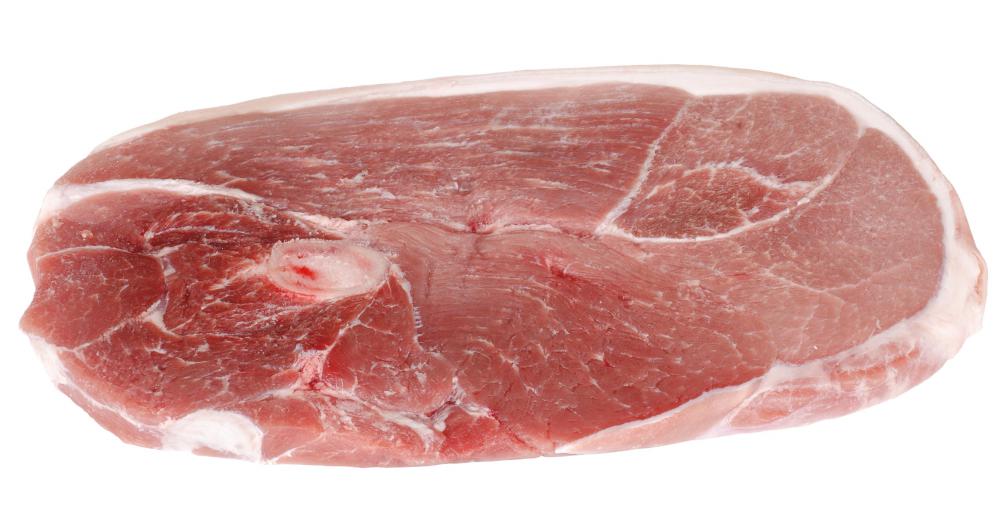At DelightedCooking, we're committed to delivering accurate, trustworthy information. Our expert-authored content is rigorously fact-checked and sourced from credible authorities. Discover how we uphold the highest standards in providing you with reliable knowledge.
What is a Meat Processing Plant?
A meat processing plant is a business that kills and processes animals into meat for human consumption. Meat processing plants are also referred to as slaughterhouses. Animals bred for consumption are sold by farmers, who are paid for the live weight of the animal, and then shipped to a meat processing plant where they are killed using approved methods. After the animals are killed, they are cut apart into common cuts of meat.
Meat processing plants have existed in the United States since 1928. Early European maps suggest meat processing plants in Europe date back prior to the 1900s and were often found in open air markets. Conditions in early meat processing plants in both Europe and the United States were often unsanitary and unsafe. Workers were paid low wages and there were few controls to ensure safe and efficient food production.

Government regulations began evolving during the Industrial Age in both Europe and America. Rules were put into place to ensure the humane treatment of animals, the fair treatment of workers, and the sanitary processing of food. In the US and Europe, civil law controls conditions in most meat processing facilities. Steam, hot water, and organic acids are used to minimize the growth of bacteria and to pack meat safely.

Most animals at meat processing plants are killed either by a jolt of electricity, CO2 gas, or captive bolt pistol. In some cases, animals must be killed according to kosher laws, if the plant is processing kosher meat. After the animals are killed, their carcasses are hung up and inspected by government agents. In the United States, the Food Safety Inspection service inspects meat, while in Canada the Canadian Food Inspection Agency performs this function.

Generally, each meat processing plant only processes one type of animal. The meat processing plant may pack the meat from this animal using a number of different methods. The meats may be cured, smoked, or cut. Waste products, such as bone and lard, are then sent to rendering plants or waste treatment plants. The meat is then shipped to grocery stores and other buyers or to a cold storage facility.

Some meat processing plants do not slaughter animals at all. Meat processing plants fall into three major categories: slaughter and process plants, processing only plants, and cold storage plants. A processing only plant is a plant that receives animal carcasses and packs the meat for production. A cold storage plant stores meat that was processed at a remote meat processing plant.

Meat processing plants are designed to streamline food production in order to ensure an adequate supply of quality food. In some locations within the United States, Canada, and Europe, farmers who raise meat for consumption must send the meat to processing plants or go through special training to become licensed to process the meat themselves.
AS FEATURED ON:
AS FEATURED ON:
















Discussion Comments
@Iluviaporos - I don't think what will happen is that people will suddenly lose the taste for meat. I just don't think capitalism works that way.
I suspect what is going to happen in the next few decades is that meat processing plants will be replaced by factories that generate meat grown from vats of some kind. They've already started doing this, they just need to make the process cheaper.
And since it's free from pesky intestines and bones, it will be a lot easier and safer to process.
@Fa5t3r - I think the problem is that people expect to be able to buy meat as a staple, rather than as a condiment, and it has led to all kinds of problems with the environment and human rights and sanitation. Companies have had to cut corners to provide meat at the prices that people expect.
In the long run, I'm afraid the real answer is for people to stop eating so much meat. I don't advocate that people should stop eating meat altogether like some do, but everyone definitely needs to start treating it like a luxury rather than a given.
Meat is a very resource intensive, labor intensive product no matter how you try to cut back on processing costs. And we're at the point where the cut backs are seriously affecting safety standards for everyone concerned.
The regulation of meat processing plants is often not strict enough. They exploit workers by forcing them to work in unsafe, unsanitary conditions and the meat is often contaminated. People think it isn't that bad until they realize that a carcass will also contain fecal matter and if that isn't disposed of properly it will end up in the meat. Often the companies will simply bleach the meat after it happens rather than preventing it from happening in the first place.
I've witnessed the slaughter of animals in third world countries where the meat was sold in open-air markets and, frankly, it was probably more sanitary than what goes on in many developed countries, not to mention much safer for the workers.
Post your comments